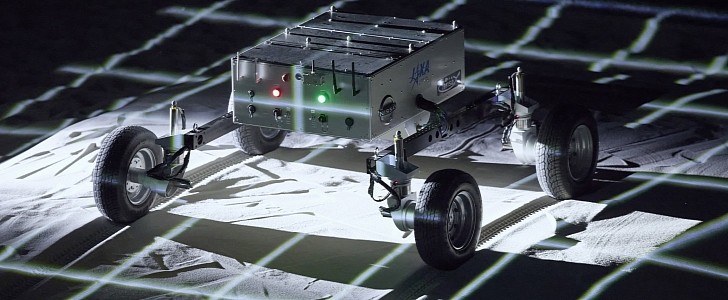Ever since NASA announced it is going back to the Moon, it was clear astronauts who will land there will at one point need some type of means of transportation, other than their own legs. Just as it happened in the years of the Apollo program, Artemis too will have its own rover, meant to roam the unbeaten paths of Earth’s satellite.
It will generically be called Lunar Terrain Vehicle (LTV), and at the time of writing it only exists as a Request for Information (RFI) submitted by NASA back in 2020. No deadline for the delivery of the prototype was set, and the full specs are not known. Yet, this is not stopping companies like Northrop Grumman, Lockheed Martin, and GM from announcing their intention to take part.
Back in December of last year, we’ve learned about the Japanese from Nissan working together with the Japan Aerospace Exploration Agency (JAXA) on a moon rover. Not aimed specifically at the Artemis program, it provided the carmaker with enough incentive to get involved with the LTV as well.
This week, during the Space Symposium held in Colorado Springs, Colorado, Teledyne Brown Engineering announced it too is working on an LTV, and it will not do it alone. For the project, the company brought on board both Nissan and Sierra Space.
As per the details provided, Teledyne is the leader of the project, and will bring to the table the program management, engineering, manufacturing, integration, operations, and the power system for the LTV.
Sierra Space is in charge with the development of the flight software, space-qualified mechanisms, communications, pointing, navigation, and timing.
Last but not least, Nissan has been tasked with... well, it’s a bit unclear what Nissan will do, apart from offering “deep knowledge into autonomous driving and intelligent vehicle systems.”
The details released so far by NASA on the LTV it is looking for point to it being capable of carrying up to 500 kg (1,100 pounds) of weight, including two fully suited astronauts. It must move across lunar highland terrain, and be able to navigate slopes of at least 15 degrees. It will have to be able to operate in temperatures ranging from 280 to minus 280 degrees Fahrenheit (138 to minus 173 degrees Celsius).
It will be an electric machine, with a battery that can be recharged “from internal power generation sources and from other lunar surface assets.”
As said, there’s no clear date as to when the first prototype will surface. NASA is in no hurry, as the first crewed Artemis missions have been planned without the need for a rover.
Back in December of last year, we’ve learned about the Japanese from Nissan working together with the Japan Aerospace Exploration Agency (JAXA) on a moon rover. Not aimed specifically at the Artemis program, it provided the carmaker with enough incentive to get involved with the LTV as well.
This week, during the Space Symposium held in Colorado Springs, Colorado, Teledyne Brown Engineering announced it too is working on an LTV, and it will not do it alone. For the project, the company brought on board both Nissan and Sierra Space.
As per the details provided, Teledyne is the leader of the project, and will bring to the table the program management, engineering, manufacturing, integration, operations, and the power system for the LTV.
Sierra Space is in charge with the development of the flight software, space-qualified mechanisms, communications, pointing, navigation, and timing.
Last but not least, Nissan has been tasked with... well, it’s a bit unclear what Nissan will do, apart from offering “deep knowledge into autonomous driving and intelligent vehicle systems.”
The details released so far by NASA on the LTV it is looking for point to it being capable of carrying up to 500 kg (1,100 pounds) of weight, including two fully suited astronauts. It must move across lunar highland terrain, and be able to navigate slopes of at least 15 degrees. It will have to be able to operate in temperatures ranging from 280 to minus 280 degrees Fahrenheit (138 to minus 173 degrees Celsius).
It will be an electric machine, with a battery that can be recharged “from internal power generation sources and from other lunar surface assets.”
As said, there’s no clear date as to when the first prototype will surface. NASA is in no hurry, as the first crewed Artemis missions have been planned without the need for a rover.





























